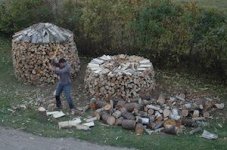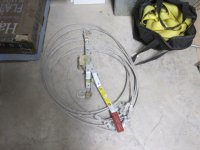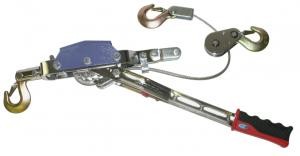Another Narrow Escape
Sunday afternoon, my wife and I loaded into the back of the truck the
freezer that died last year while we were still living in the camper. The junk freezer has been sitting on our property long enough. You can see it on the right side of the first picture. Since we are having a couple big gatherings at our house over Thanksgiving, my wife decided it was time for the freezer to vacate the property. I hurt my back a few years ago moving this freezer. Now I have a tractor. Lifting it into the truck was a breeze this time.
While I was on the tractor, I decided to haul off a couple of stumps to our stump dump which is down a steep hill in the woods. Rain was in the forecast so I wanted to get this done before the ground got wet. I made sure the tractor was in low gear and 4WD and headed down the steep downhill path through the woods. After dumping the stumps on the pile, I put the tractor into reverse so I could back up the hill. I have done this same maneuver a few times before. I could not turn the tractor around and face uphill for rear of rolling the tractor if I got it sideways.
However, when I put the tractor in reverse, the tires just spun in place. I saw quickly that there was no way I was going to be able to drive the tractor backwards back up the hill. The ground was wetter than I had thought. Plus, I had no weight on the rear of the tractor to give the rear wheels some traction. I had removed the box blade the day before in order to move the trailer with the tractor.
Too make things worse, it was starting to lightly rain. We had several days of rain in the forecast and we are approaching the wet season in this area. If I did not get the tractor back up the hill out of the woods within the next couple of hours, I didn't know when it would be feasible to get the tractor out of that spot. It could be months before the path down that hillside dried out. I parked the tractor and ran to get my wife. On the way back, I brought a chain, two steel cables, and an almost useless come-along we bought from Lowes when we
rescued my tractor a year ago.
We hooked the come-along to a tree and hooked the cables and chain to the tractor. While turning the tractor tires in reverse, my wife tried to crank the come-along without any success. The come-along could not pull the tractor up the hill. Meanwhile, the rain continued to threaten and we got spurts of light drizzle and the ground just got wetter. I then tried to use the FEL bucket to push the tractor up the hill while keeping the tractor tires moving in reverse. This method worked and could move the tractor 6 inches to a foot when the operation was done successfully. However, the tractor just as easily would slide back downhill into the holes made by the spinning tires.
Thus, I would use the FEL to push the tractor up the hill while my wife cranked on the come-along. The come-along did not help pull the tractor up the hill but it did prevent the tractor from sliding back down the hill. We inched the tractor up the hill in this fashion as the conditions continued to get wetter. Every 4 or 5 feet, we would have to reposition the come-along, cables, and chain when the ran out of come-along cable. I would say we did this routine for about 40 feet until the hill got a little less steep and the tractor tires finally got traction.
I was a very happy camper when we got the tractor out of that predicament! If I had been by myself, I couldn't have gotten the tractor up that hill. I'm not exagerating when I say I don't know when we would be able to retrieve the tractor due to the approaching we season if we weren't able to rescue it when we did. It rained 4 staight days beginning the day I got stuck down the hill. We would probably have needed to hire a tow truck with a winch to come winch the tractor up the hill. I'm assuming a tow truck winch could pull the tractor up that hill but don't really know for sure.





